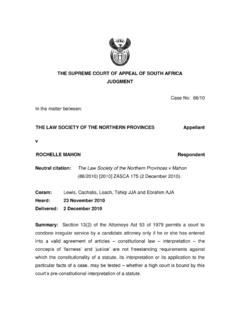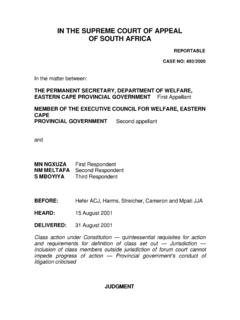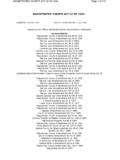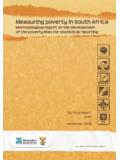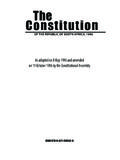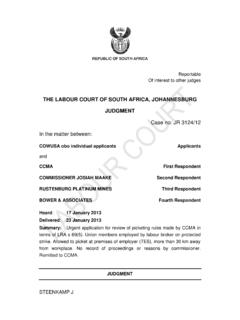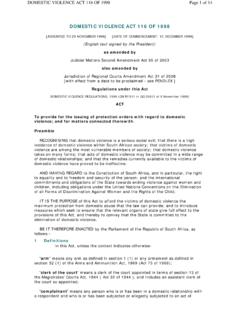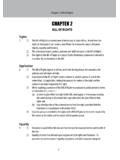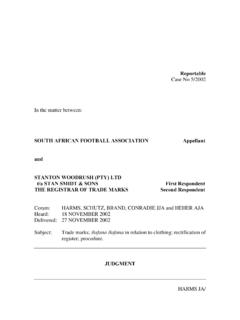Transcription of THE SUPREME COURT OF APPEAL OF SOUTH …
1 THE SUPREME COURT OF APPEAL OF SOUTH africa JUDGMENT Case no: 007/11 SOUTH AFRICAN TRANSPORT AND ALLIED WORKERS UNION Appellant and JACQUELINE GARVIS First Respondent THURAYA NAIDOO Second Respondent CHINATOWN (RSA) INTERNATIONAL TRADING CC Third Respondent ANEES SOEKER Fourth Respondent ANDREWS NJIOKWUEMEGI Fifth Respondent DOLORES ROSANNE REITZ Sixth Respondent MAURICE ROBERTSON Seventh Respondent HAROLD BURGER Eighth Respondent MINISTER OF SAFETY AND SECURITY Ninth Respondent _____ Neutral citation: SOUTH African Transport & Allied Workers Union v Garvis & others (007/11) [2011] ZASCA 152 (27 September 2011) CORAM: Navsa, Brand, Van Heerden, Mhlantla JJA and Plasket AJA HEARD.
2 5 September 2011 DELIVERED: 27 September 2011 SUMMARY: Constitutional validity of s 11(2)(b) of the Regulation of Gatherings Act 205 of 1993 protest march organised by Trade Union degenerating into riot damage caused to property persons affected sued Trade Union in terms of s 11 of the Act high COURT called upon to decide the separated question of the constitutional validity of s 11(2)(b) Trade Union contending that right to freedom of assembly and protest entrenched in s 17 of the Constitution infringed by the creation of statutory liability without providing a viable defence submitted that holding organisations that organised assemblies and marches liable would have a chilling effect high COURT correct in concluding that s 17 of the Constitution not implicated assemblies that were peaceful and in which participants were unarmed were protected held that s 11(2)(b)
3 Was not internally contradictory and provided viable defences to organisers organising a march preceded by many deaths and increasing animosities might in itself lead to liability Evidence presented in the COURT below indicated that notwithstanding the existence of s 11 gatherings continuing to be a feature of SOUTH African life and that there was no chilling effect warning by COURT about being subjected to mob rule. _____ 2_____ ORDER _____ On APPEAL from: Western Cape High COURT (Cape Town) (Hlophe JP sitting as COURT of first instance): The APPEAL is dismissed and no order is made as to costs. _____ JUDGMENT _____ NAVSA JA (Brand, Van Heerden, Mhlantla JJA and Plasket AJA concurring) [1] On Tuesday morning 16 May 2006 the appellant, the SOUTH African Transport and Allied Workers Union (the Union), arranged and organised a protest march, which constituted a gathering as defined in the Regulation of Gatherings Act 205 of 1993 (the Act).
4 The march in the Cape Town City Bowl arose out of a protracted strike in the security sector by members of the Union. As the march proceeded, in the Union s own words, it descended into chaos , with admitted extensive damage caused to vehicles and shops along the route. [2] The first to eighth respondents are individuals who claimed that they had sustained loss as a result of the riot. At least one of the respondents claims to have been assaulted. They all instituted action in the Western Cape High COURT , Cape Town, against the Union in terms of s 11 of the Act, alternatively under the common law, to recover the damages they had allegedly sustained and for which they contended the Union was liable. Section 11(1) of the Act creates a statutory liability on the part of organisations under whose auspices a gathering or demonstration was held that degenerated into a riot causing damage to 1 Section 11(1) provides: If any riot damage occurs as a result of- 3 [3] Section 11(2) of the Act sets out three factors that a defendant to such an action has to prove in order to escape liability.
5 Section 11(2) reads as follows: It shall be a defence to a claim against a person or organization contemplated in subsection (1) if such a person or organization proves (a) that he or it did not permit or connive at the act or omission which caused the damage in question; and (b) that the act or omission in question did not fall within the scope of the objectives of the gathering or demonstration in question and was not reasonably foreseeable; and (c) that he or it took all reasonable steps within his or its power to prevent the act or omission in question: Provided that proof that he or it forbade an act of the kind in question shall not by itself be regarded as sufficient proof that he or it took all reasonable steps to prevent the act in question. (My emphasis.) [4] In defending the action the Union, in addition to denying liability in general terms, also contended that s 11(2)(b), particularly the part highlighted above, places too great a burden on trade unions and other organisations and individuals who intended to assemble to protest publicly.
6 It was submitted that it has a stultifying effect on the rights set out in s 17 of the Constitution: Everyone has the right, peacefully and unarmed, to assemble, to demonstrate, to picket and present petitions. [5] Put differently, it was contended that, faced with the onerous task of proving what is required by s 11(2)(b), unions, other organisations and individuals would be deterred from organising marches, protests and other gatherings for fear of financial ruin. Thus, it was contended that s 11(2)(b) was unconstitutional in that it offended against the right entrenched in s 17 of the Constitution in terms of which everyone has the right peacefully and unarmed , to assemble, demonstrate, picket and to present petitions. (a) a gathering, every organization on behalf of or under the auspices of which that gathering was held, or, if not so held, the convener; (b) a demonstration, every person participating in such demonstration, shall, subject to subsection (2), be jointly and severally liable for that riot damage as a joint wrongdoer contemplated in Chapter II of the Apportionment of Damages Act, 1956 (Act 34 of 1956), together with any other person who unlawfully caused or contributed to such riot damage and any other organisation or person who is liable therefor in terms of this subsection.
7 4[6] In the paragraphs that follow, I turn to consider the allegations by the respondents about the riot as experienced by them and the resultant damage allegedly sustained by them. The allegations in relation to the first, second and sixth respondents that appear in those paragraphs are drawn from affidavits filed by them, after an order by the COURT below in terms of which the issue of the constitutionality of s 11(2)(b) was, in terms of Uniform rule 33(4), to be heard prior to and separately from the other issues in the case,2 and from their particulars of claim. The assertions by the third, fourth, fifth, seventh and eight respondents are drawn from their particulars of claim. [7] The first respondent, Ms Jacqueline Garvis, alleged that at the time of the riot she was a street vendor selling items such as travel bags, school bags, wallets, etc at a location just outside Grand Central.
8 She described how, on the morning in question, a group of marchers pushed through a gate to the market where her stall was located. One of the persons in the group used a pole with which he smashed her stall. Parts of the crowd looted her stall and robbed her of all her stock. She was struck on her body with a pole and was traumatised by the events. She alleged that the replacement value of the goods lost by her was R3 805. [8] The second respondent, Ms Thuraya Naidoo, is a flower seller who does business on the pavement alongside Adderley Street, near the intersection with Darling Street, in the centre of Cape Town. She alleges that she was aware that the Union had organised a march for the 16 May 2006. On that day she was going about her business as usual when, at approximately 11h30, a huge crowd approached and a group of marchers trampled her flowers. She was terrified as she witnessed her business and stock being destroyed.
9 According to Ms Naidoo it took her months to pay off her debt to the person who supplies the flowers she sells in her business. She alleged that the replacement value of the flowers lost by her is R6 2 The COURT below, in ordering the separation, granted leave to any party wishing to adduce evidence in relation to the constitutional point to do so by filing affidavits. 5[9] The sixth respondent, Ms Dolores Reitz, recalls that on that morning she was in her car at a set of traffic lights in Darling Street. At the time, she was a manager of a photographic shop in the Strand Concourse and was on the way back there from a goods supplier. Suddenly, she was surrounded by a group of marchers who smashed her car with sticks and their fists. The car was consequently badly damaged and she was terrified.
10 In her particulars of claim she alleged that she had suffered damages in the amount of R5 [10] The fourth respondent, Mr Anees Soeker, is a carpenter who claimed that his motor vehicle was vandalised during the march, causing him to sustain damages in an amount of R17 [11] The fifth respondent, Mr Andrew Njiokwuemegi, a customs clearance officer, also alleged that his car was vandalised during the march, causing him to sustain damages in an amount of R11 [12] The seventh respondent, Mr Maurice Robertson, a businessman, claimed that he had his motor vehicle vandalised during the march and that he sustained damages in an amount of R5 [13] Finally, the eighth respondent, Mr Harold Burger, who is self-employed, stated that his motor vehicle was vandalised by marchers and that he consequently sustained damages in an amount of R18 [14] In an affidavit filed in the proceedings in the COURT below subsequent to the order in terms of Uniform rule 33(4), Mr B J Engelbrecht Botha, who is employed as legal advisor to the Speaker of the City of Cape Town, stated that in the riot following on the march, participants began breaking windows, damaging cars and looting stores, causing damage estimated to be in the region of million.
